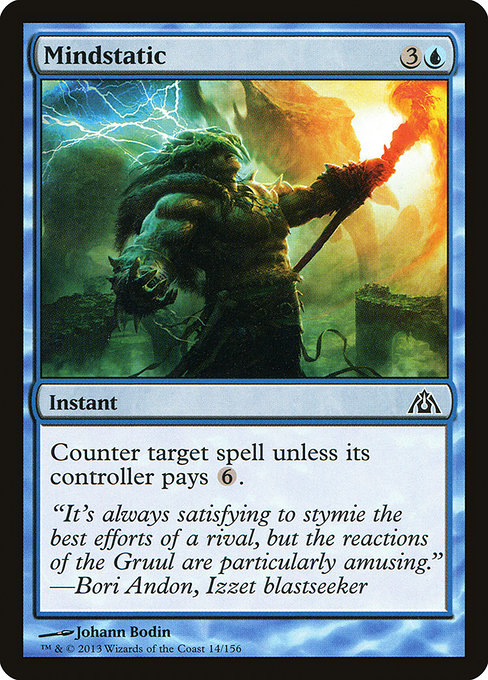
Image courtesy of Scryfall.com
Design consistency across related archetypes: Mindstatic as a lens for blue’s strategic identity
Magic’s color pie has long celebrated consistent design threads that help players anticipate how a given color will feel across different decks and formats. Blue archetypes, in particular, lean into tempo, card advantage, and countermagic that punishes reckless plays. Mindstatic, a Dragon's Maze instant, embodies a clean, recognizable rhythm: a four-mana spell that pivots around countering a threat, but with a cost that forces the opponent to weigh their options. This is blue through and through—calculated, precise, and a bit gleeful when the opponent misreads the moment 🧙♂️🔥💎. The card’s presence in Dragon's Maze also reminds us of how multi-color environments push designers to thread consistency across colors and sets, keeping the feel of blue coherent even as it coexists with other motifs in a guild or shard block 🎨⚔️.
Mechanics and color identity: Mindstatic as a case study in blue control
Mindstatic costs {3}{U} and resolves as an instant, which is a familiar blue tempo frame. The text—“Counter target spell unless its controller pays {6}”—wraps a classic counterspell concept in an ultimatum twist. That twist isn’t arbitrary; it reinforces blue’s strategic ethos: you don’t get a free counter every time you mulligan into this—you must commit to paying a hefty mana tax or let the spell resolve. The effect is elegant design economy: it rewards timely, targeted disruption while introducing a strategic risk for both players. It’s not a “lock everything down” spell; it’s a calibrated tool that shines when you’re sequencing threats, bluffing, and managing mana efficiently. In other words, Mindstatic exemplifies the deliberate pacing you expect from blue: tempo, control, and the satisfaction of predicting an opponent’s line and cutting it off just short of critical parity 🧙♂️⚡.
The rarity and printed milieu matter too. Mindstatic sits as a common card in Dragon's Maze (a set that invited multi-color synergy and Guild-centric design themes). Its true artistry lies in how its utility scales with the game state. In a game where a late-game bomb is looming, Mindstatic can derail a plan if you have the blue mana to deploy it at the right moment. The card’s mana cost and its taxing effect reinforce a design pattern shared by other blue tools across related archetypes: a reliable, if situational, answer that expects you to weigh tempo against inevitability. That balance—predictable enough to teach players the right tempo, surprising enough to reward a well-timed play—is a hallmark of consistent archetype design across sets and formats 🔎🎯.
“It’s always satisfying to stymie the best efforts of a rival, but the reactions of the Gruul are particularly amusing.” —Bori Andon, Izzet blastseeker
Flavor text aside, the synergy here also highlights the designer’s connective tissue: Mindstatic shares a linguistic and thematic thread with other blue spells that pivot on counterplay and strategic tax. In Dragon's Maze, you’ll often see blue paired with other tactics—cool, calculated responses that don’t overstay their welcome. The art and wording work together to keep blue’s identity intact across a sandbox that blends multiple guild vibes. The name Mindstatic itself conjures a mental tug-of-war, a playful nod to the card’s reactive posture while still feeling like a piece in a broader blue constellation 🧠🔬.
Art, flavor, and how consistency fuels collector appeal
Beyond raw gameplay, Mindstatic’s presentation—Johann Bodin’s illustration, the Dragon's Maze border, and the card’s straightforward, memorable effect—sells a cohesive narrative. When players collect or draft in archetype-focused environments, they look for recognizable cues: a counterspell wedge that isn’t frustratingly abstruse, a cost that makes sense for the tempo it enables, and flavor that invites you to imagine the moment in which a spell fizzles into a high-stakes, high-drama counter-counterplay. The “6” tax on the counter is a deliberate, almost theatrical set-up—blue’s brash insistence on control that still respects the peril of overextension. That’s design consistency in motion, and it threads through related blue archetypes across sets, giving players a reliable mental map for how blue strategies should feel 🧭🎲.
As you prep for a night of drafting or a weekend commander session, the Mindstatic moment becomes a microcosm of archetype design philosophy: clear color identity, a defined risk-reward curve, and the satisfaction of outmaneuvering an opponent who overcommits to their plan. It’s the kind of card that makes you nod and say, “Yep, blue did that.” And for fans who love the tactile ritual of gathering, the card’s collectible aura—foil vs. nonfoil, set placement, and market price hints—adds another layer of consistency: a familiar silhouette in a familiar environment, with a dash of Dragon's Maze’s signature chaos 🧙♂️💎.
Speaking of collecting and gear, if you’re building a vibe to accompany those late-night drafting sessions or tabletop tournaments, you might want to lean into the neon aesthetic that mirrors Mindstatic’s crisp, electric feel. This is where real-world products become a natural extension of the MTG experience. For a desk setup that sparks as much joy as a well-timed countermagic, check out the Custom Neon Mouse Pad—9.3 x 7.8 inches, non-slip, perfect for long grind sessions or casual skirmishes. It’s the kind of accessory that doesn’t just look cool; it echoes the focused mindset blue players strive for in every game 🔷🖱️.
To explore more gear that fits the mood, follow the product link below and see how design-minded accessories can complement your MTG play space. And when you’re ready to dive into related reads, our network has you covered with guides on strategy, deckbuilding constraints, evolving mechanics, and drafts that sharpen your edge 🔥🎨.
Custom Neon Mouse Pad (9.3 x 7.8 in, Non-Slip Desk Pad)
More from our network
- https://crypto-acolytes.xyz/blog/post/diablo-4-vs-path-of-exile-endgame-loot-and-skills/
- https://blog.digital-vault.xyz/bolg/category/guides/
- https://blog.digital-vault.xyz/blog/post/why-constraints-elevate-adarkar-sentinel-deckbuilding/
- https://blog.digital-vault.xyz/blog/post/how-aerith-gainsboroughs-mtg-mechanic-evolved-across-sets/
- https://blog.digital-vault.xyz/blog/post/draft-strategy-insights-flashfires-and-red-instants-in-limited/